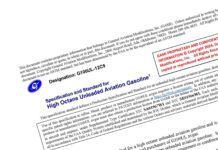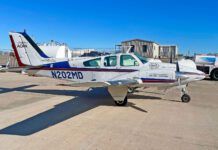Compared to piston aviation fuels research, mushroom farming is a daylight operation. Thats not to say the fuel work is secretive, its just that it goes on more or less constantly, but nothing meaningful seems to come of it. At least you can have the mushrooms on your salad. Against this backdrop of apparent non-action comes yet another entrant into the 100LL replacement sweepstakes, this one called G100UL. This new fuel comes at the problem from far out in left field from a company known more for burning fuel than creating it: General Aviation Modifications, Inc., the Ada, Oklahoma, mod house that shook up the hidebound world of aircraft engine research with its radical ideas on lean-of-peak operation and an almost religious conviction that turbonormalized engines are better than turbocharged engines. With G100UL, GAMI is again running against the grain and, to a degree, challenging the accepted notion that before a new fuel can be widely tested, it has to be certified. But, says GAMIs George Braly, thats backwards. There’s no point in reducing entire forests to pulp to certify a fuel if refineries arent interested in or cant build the stuff profitably, thus GAMIs idea is to field its new developmental fuel to a select fleet under an STC while simultaneously pursuing regulatory approval. To a degree, that will test the economics, too, since production will have to rise to at least the pilot-plant level to supply a small fleet experiment. The very existence of 100LL has been under threat since amendments to the Clean Air Act of 1970 eliminated the use of tetraethyl lead as an octane enhancer in motor fuels. Because it couldnt be shown that aircraft engines could safely operate on lower octane unleaded fuels, general aviation has operated under a “temporary” lead-content waiver for the past quarter century. Year after year, the government has been talked out of or just hasnt shown committed interest to drop the hammer on TEL once and for all. However, the current urgency to find a replacement for TELs octane pop comes from a new lead initiative by the EPA. A petition filed by the Friends of the Earth in 2007 asked the EPA to set new, more stringent standards for lead air pollution. As part of that regulation, EPA is requiring air monitoring around airports to determine what levels of airborne lead exist, but the new rule sets 2011 as a deadline for reducing lead emissions. (See sidebar.) Its impossible to predict where this monitoring will lead or how fast it may develop into a regulation that would eliminate 100LL entirely. Braly thinks the danger is clear and present and has thus launched his own fuels research project on an engineers hunch that the solution may reside in current technology. In fairness, its not like the industry hasnt been trying. Between the engine manufacturers, the FAAs Atlantic City William J. Hughes Technical Center and the oil companies, lead-free experimental blends in the dozens have been tried. More than a few have proven promising, although none have the attractive combination of TELs seamless octane enhancement and relatively cheap price. An insistence that a lead-free fuel exactly meet the avgas standard, ASTM D910, has complicated the search for a replacement by eliminating some near-hit choices. Braly believes G100UL meets D910 with no significant departures.
Why the push?
GAMI invited us to the companys Ada, Oklahoma, research facility to observe some test cell runs and actually fly with G100UL. So what is the stuff? Braly declined to reveal the exact formulation due to proprietary and competitive concerns, but says he will reveal more when further testing is completed.
Braly did confirm that G100UL is largely high-octane, unleaded gasoline feedstock blended with components that are more or less standard hydrocarbon chains from materials that any refinery can derive from known petroleum refining techniques. Its not bio-derived, as Swift Fuel is.
However, in the recent past, some fuel formulations have been proved to work including ethyl tertiary-butyl ether (ETBE) or methyl tertiary-butyl ether (MTBE). Although these compounds are out of favor for being implicated in groundwater contamination, research indicates they do provide the required octane. In Europe, Hjelmco Oil has developed an ETBE-laced 100-octane fuel that the companys Lars Hjelmberg says could be certified in the U.S. The FAA has no beefs with ETBE, but EPA might.Another possibility tried before is the so-called high aromatics, such as toluene or the benzene groups. This is essentially how Swift Fuel is blended, using bio-derived acetone as a feedstock. It seems plausible that the same thing could be done using petroleum-derived feedstock by simply manipulating the distillation process, which is what refining is all about anyway.
“Yes, it might work, I suppose,” says Rob Midgley, Shells global technology manager, when we asked about the plausibility of a Swift Fuel approach derived from oil instead of saw grass. And what of the economics?
“Oh, who knows?” he said, which mirrors the reaction we get from other oil refining insiders when asked how plausible the numbers are. The problem is that refineries, despite buying billions of dollars worth of crude a year, operate on tiny margins. A misplaced decimal point in a feasibility study can turn what looks like an acceptable profit into a disaster.
Braly concedes that this is a major hurdle that G100UL will have to leap. “This has always been a chicken and egg problem,” he told us. “If youre going to get the refiners interested, you have to show them a fuel that works, but if youre going to show them it works, you have to build enough of it to test it widely.”
Testing
Toward that goal, by early February, GAMI had run about 25 hours of test cell work on a beaten down IO-550 used for its Cirrus turbo work. In addition, it has flown three test flights, one of which we came along on to help collect data and observe results.
The single largest concern-apart from economics-is motor octane rating. The ASTM D910 spec for avgas calls for 99.6 MON minimum, but most FBO 100LL is a bit over that, at 101 to 103 octane. Presumably, G100UL would have similar variability due to vagaries in the refining process, but Braly told us in the laboratory test version, the fuel easily exceeds the D910 minimum.
At that octane, youd expect G100UL to have good detonation characteristics and it does. In the test cell runs we observed, 100LL and G100UL had detonation profiles that were too close to distinguish and both have more than enough margin to meet typical FAA detonation standards.
Braly also ran some 95-octane unleaded fuel and some so-called “min spec” avgas, whose octane was actually at the lowest end of the ASTM requirement. Both of these induced light to medium detonation at cylinder head temperatures not much above what most of us would consider the high side of normal. A couple of octane points make a dramatic difference in delaying the onset of the detonation.
ASTM D910 has a number of other requirements including vapor pressure, boiling and freezing points, sulfur content, corrosion characteristics, aging and oxidation requirements and water reaction qualities. A significant worry about fuels with high aromatic content is seal, hose and O-ring swelling.
“There have been problems with aromatic contents higher than about 40 percent in aviation fuels. Its not just as simple as raising the octane number,” Shells Midgley told us. So-called phase separation of water has been an issue in fuels with ethanol but it appears not to be in G100UL. In fact, Braly told us G100UL meets the D910 spec line for line with the exception of having no lead, slightly lower energy per unit of weight and some departures on distillation end points. As for seals and hoses, soak testing was underway when we visited, including containment in a composite tank. Braly said no problems had cropped up.
The fuels energy density produced some interesting results in the test cell and in the airplane. At equivalent power output, in one case about 319 HP, we noted that fuel flow for G100UL was 26.7 GPH but 28.2 GPH for 100LL.
But because G100UL is heavier, there’s a payload hit-it would be about 30 pounds for a 75-gallon fill-up. But you can get the same range for less fuel volume, so the overall impact on range is under 5 percent. With full tanks, range is extended by about the same amount. In other words, G100UL is almost a wash against avgas. Youd hardly need to factor it into flight planning. Swift Fuel is considerably heavier at 7 pounds per gallon. The same 75-gallon tank would be 75 pounds heavier and although Swift also has a higher energy density-13 percent-the volume-against-weight equation means slightly less range. In our view, this isn’t a significant operational consideration, either.
The FAA doesnt quite know what to do with G100UL, because its being developed in a sort of business-to-business model and not the historic FAA/Coordinated Research Council network. Braly has proposed to the FAA that G100UL be fast tracked by approving an STC to test it in a limited number of Cirrus aircraft. He argues that these airplanes are equipped with sophisticated engine monitoring, providing no better opportunity for accelerated fleet testing while GAMI pursues ASTM approval.
However, the FAA is pushing back on this idea, preferring to leave all fuel approvals to the ASTM process, which could take months, if not years. Meanwhile, the EPAs lead-regulation clock appears to be ticking.
At this point, its too soon to declare G100UL the winner of the new aviation fuel sweepstakes. We don’t know enough about its formulation and economics. But given that its petroleum derived rather than bio-mass derived, it looks for promising for now. The to its future is how fast a testing and refinery project can move forward to prove it out. Or not.




